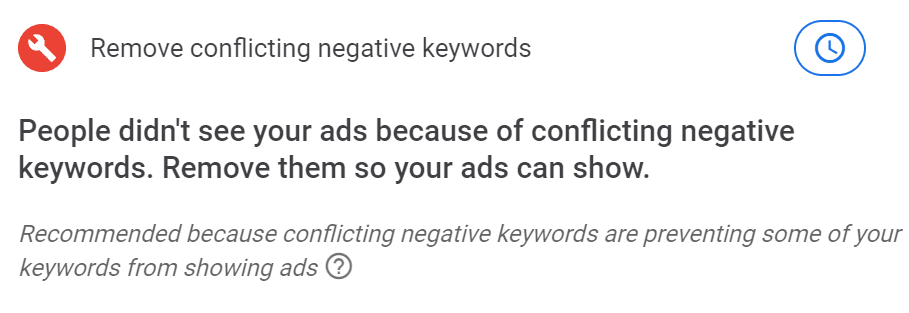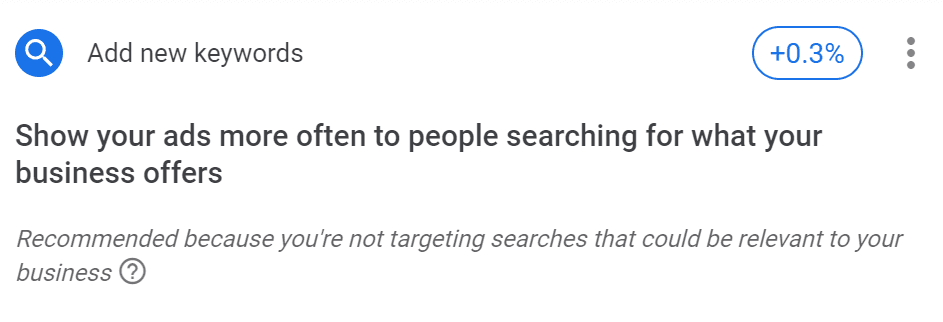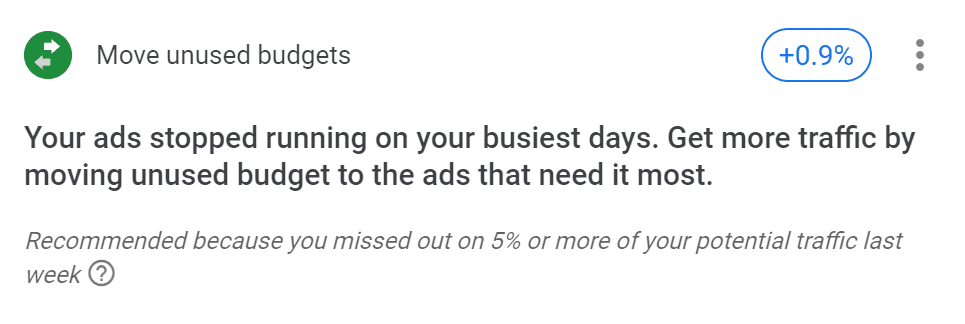Have you noticed that your campaigns are now being graded? These scores are part of Google’s Optimization Score, a new Google Ads feature announced in July 2018. Ranging from 0% to 100%, the scores are “an estimate of how well your Google Ads account is set to perform,” and can be improved by applying Google-selected recommendations to your bids & budgets, keywords & targets, ad & extensions, and more.
 While this score is not directly tied to quality score or ad rank, the recommendations are meant to improve your campaign performance. However, what represents a healthy account to Google might not look the same to you as an account manager.
While this score is not directly tied to quality score or ad rank, the recommendations are meant to improve your campaign performance. However, what represents a healthy account to Google might not look the same to you as an account manager.
In order to strategically work through your OptiScore recommendations, I’ve compiled common recommendations below into three groupings: Go, Wait, and Stop.
Go
These recommendations are generally safe and can improve your account performance.
Ad improvements
Recommendations such as “fix your ad text,” “create new versions of your ads,” and “add responsive search ads” are welcome constructive criticism to your account. Fixing your ad text will allow once disapproved ads to begin showing, and injecting & testing new ad copy and ad types to your rotation can help you achieve a higher CTR.
 Remove conflicting negative keywords
Remove conflicting negative keywords
Keyword strategies and product offerings can change over time, and what was once a smart negative keyword may no longer be needed. This recommendation will help quickly highlight where you might be blocking relevant traffic in your search campaigns.
 Automated bidding projections
Automated bidding projections
It can often be difficult to predict how a campaign will respond when switching from a manual of semi-manual bidding strategy to an automated one. Optiscore can help with that by projecting the estimated change in weekly conversions, CPA, cost and other metrics if a bidding strategy is applied. This will give you the confidence to either strategically test or intelligently avoid a given strategy:
 WAIT
WAIT
These recommendations may improve account performance but should not be applied with one click.
Expanding your reach: Display network & search partners
The Search Network, Search Partner Network, and Display Network can all perform very differently.
In many instances, it’s best to keep display traffic in its own campaign so that budgets and bids can be managed separately.
Search Partners can improve both reach and revenue, but first evaluate how this network has performed for other campaigns in your account by using the Network segment.
 New keywords
New keywords
If you have a specific campaign, ad group, and keyword organizational structure, Google might ignore that and suggest adding new keywords to an ad group and/or campaign that does not fit that structure.
To avoid this, use the download feature, sort through the list to determine keywords that are truly relevant to your account, and then upload them according to your chosen structure.
The list of suggested keywords can also be extremely large (I’ve encountered over 1,000), so adding them gradually can help you stay on top of any shifts in performance that may occur.
 STOP
STOP
These recommendations may provide value, but could result in spikes in ad spend.
Move unused budgets
This optimization sounds fantastic. Why not move unused spend from one campaign that doesn’t need it to one that does?
Keep in mind how you currently manage your budgets. If you have many campaigns that do not regularly use all their budget, shifting some of this budget to a consistently budget capped campaign will raise account spend.
For example, if $100 of budget is not being used in one campaign and is shifted a budget-capped campaign, you can easily go from spending an additional $100 rather than simply redistributing that $100 from one campaign to another.
Multiple this by 10 campaigns and you can see the issue. In general, be careful with all budget recommendations if you have a budget goal of any kind.
 Unfamiliar automated bidding
Unfamiliar automated bidding
Google has significantly improved its automated bidding algorithm in recent years – but be wary of new bidding strategies that you have not previously seen success with.
For example, I use Target CPA regularly and have seen success with it. However, I have never tried Maximize Clicks and therefore would proceed with caution if given this recommendation, and consider if solely increasing clicks is what I am trying to accomplish at the campaign or account level.
If you choose to try a new automated bidding strategy, consider starting small with one or two campaigns, and only expand if the strategy helps you achieve your core KPIs.
 In summary
In summary
Google Ads does not know your personal advertising goals, and therefore is not pitching these optimizations with those in mind.
Their suggestions might help with increasing clicks or revenue, or even improving quality score and lowering CPCs, but they might not allow you stay within budget or hit your target profitability goal.
Remember to prioritize your advertising goals and consider how a recommendation might help you reach them before clicking “Apply.”
To learn more about optimizing your paid Google ads, see our resources below:
- The 2020 Ecommerce Paid Search Report
- Paid Search: What Your Brand Needs to Know
- Local Campaigns: What They Are & Why Your Brand Should Use Them
- Growing Free Site Traffic With Surfaces Across Google
- Google Smart Shopping: What Your Brand Needs to Know
- Dynamic Search Ads: What Your Brand Needs to Know

 Remove conflicting negative keywords
Remove conflicting negative keywords Automated bidding projections
Automated bidding projections WAIT
WAIT New keywords
New keywords STOP
STOP Unfamiliar automated bidding
Unfamiliar automated bidding In summary
In summary
